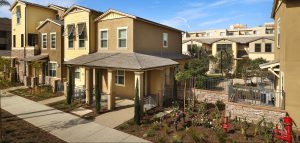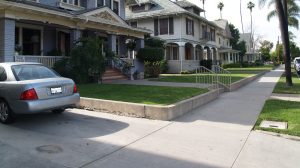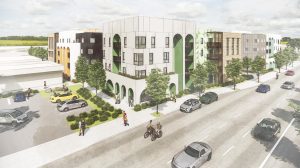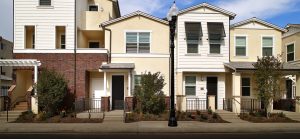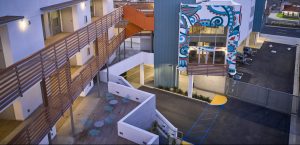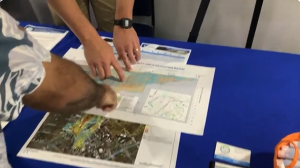|
Ref #
|
Implementation Action
|
Agency
|
Funding |
Time Frame |
GOAL HE-1: Provide sufficient rental and ownership housing opportunities and supportive services for seniors, people with disabilities, families with children, and people experiencing homelessness.
|
| =People with Disabilities |
35
|
Care Facilities
A. Conduct a comprehensive analysis of the City’s Care Home Ordinance as part of the Zoning Code Update (see program 18) to identify constraints and amend the ordinance to ensure consistency with state and federal laws, and to create barrier-free housing choices for persons with disabilities. |
PBA , Planning Division |
GF |
Dec. 2023 |
| B. As part of the Zoning Code Update (see program 18), define facilities not regulated under the Community Care Facilities Act and specify permit process consistent with state law. |
PBA , Planning Division |
GF |
Dec. 2023 |
| 36 |
Housing for People with Disabilities, including Developmental Disabilities
A. Work with affordable housing developers and the Regional Center of Orange County to expand independent living options for persons with a developmental and/or physical disability.
|
CDA, Housing Division |
CDBG, HOME,
LMIHAF, PBVs,
HOME-ARP, &
Inclusionary |
Annually |
| B. Reviewing or endorse grant opportunities, solicit applications for projects, review and facilitate new projects, or other actions to facilitate the new construction or rehabilitation of housing for persons with disabilities. |
CDA, Housing Division |
CDBG, HOME,
LMIHAF, PBVs,
HOME-ARP, &
Inclusionary |
Annually |
| C. Update the Reasonable Accommodation ordinance’s findings for approval to ensure compliance with Federal Fair Housing Acts and California Fair Employment and Housing Act by removing constraints, such as amending finding number eight, and ensuring the review process and evaluation criteria meet current fair housing requirements and HUD guidance. |
PBA, Planning Division & CDA,
Housing Division |
GF |
Dec. 2023 |
| D. Hold annual small apartment-managers’ workshop to train and educate property owners, HOAs, property managers, and tenants about best practices in property management, neighborhood safety, and landlord/tenant responsibilities (see program 44). The training will also cover specific concerns regarding families with children, occupancy standards, and reasonable accommodations and modifications. |
CDA, Housing Division |
CDBG, HOME,
LMIHAF, PBVs,
HOME-ARP, &
Inclusionary |
Annually |
| E. Provide affordable housing opportunities for people with disabilities as part of the City’s RFP for Affordable Housing Development to support the development of permanent, affordable, and accessible housing that allows people with disabilities to live independent lives. |
CDA, Housing Division |
CDBG, HOME,
LMIHAF, PBVs,
HOME-ARP, &
Inclusionary |
Annually |
| F. Provide financial assistance to single-family homeowners and renters to make ADA-accessible improvements to their homes. |
CDA, Housing Division |
CDBG & HOME |
Ongoing |
| People Who Are Experiencing Homelessness |
| 37 |
Emergency Shelters and Transitional Housing
A. Continue to provide funding for providers of emergency shelter and permanent supportive housing for people who are experiencing homelessness. Release an RFP by the end of 2022 for the delivery of permanent housing. |
CDA, Housing Division |
PLHA, Inclusionary,
HHAP, CDBG, ESG, & GF |
Ongoing |
B. Continue to facilitate establishment of emergency shelters and transitional and supportive housing throughout the planning period. Approve and finance 10 new permanent supportive housing projects
and a new 200+ bed emergency shelter in the planning period. |
CDA, Housing Division |
PLHA, Inclusionary,
HHAP, CDBG, ESG, & GF |
Ongoing |
| C. Amend the City’s Municipal Code as part of Zoning Code Update to revise its homeless shelter ordinance to comply with state law, such as AB 139 and AB 101, and most recent best practices. |
PBA, Planning Division |
GF |
Dec. 2023 |
| 38 |
Permanent Supportive Housing
A. Provide funding and technical assistance to support the development of permanent supportive housing for people experiencing homelessness. |
CDA, Housing Division |
PLHA, Inclusionary,
HHAP, CDBG, ESG, & GF |
Ongoing |
| B. Continue efforts to address Homeless Youth needs through access to permanent and supportive housing and workforce development. |
CDA, Housing Division |
PLHA, Inclusionary,
HHAP, CDBG, ESG, & GF |
Ongoing |
| C. Amend the Municipal Code to comply with AB 2162. |
PBA, Planning Division |
GF |
Dec. 2023 |
| D. As part of the RFP for Affordable Housing Development (see program 2), request proposals for permanent supportive housing from owners and/or affordable housing developers together with at least one service provider. Projects will provide affordable housing opportunities for special needs populations including, but not limited to, homeless individuals and families, and persons with a disability. |
CDA, Housing Division |
PLHA, Inclusionary,
HHAP, CDBG, ESG, & GF |
Ongoing |
| 39 |
Supportive Services
A. Annually, allocate grant funding as available to agencies that provide services to people experiencing homelessness or at risk of becoming homeless. |
CDA, Housing Division |
CDBG |
Ongoing |
| B. Every five years, participate with other local jurisdictions in the Orange County ESG Collaborative to leverage funds and ensure maximum impact. Re-evaluate and participate in ESG Collaborative for the next five-year period at the end of this term. |
CDA, Housing Division |
ESG |
Every Five Years |
| Senior Services |
| 40 |
Senior Services
A. Support food distribution programs and similar senior services. Provide a minimum of $30,000 (proportionate to funding available) to service providers that apply for funding and are eligible under CDBG. |
CDA, Housing Division |
CDBG |
Ongoing |
B. Support private and nonprofit entities to match seniors in house sharing arrangements. Provide a minimum of $30,000 (proportionate to funding available) to service providers that apply for funding and
are eligible under CDBG. |
CDA, Housing Division |
CDBG |
Ongoing |
| C. The City’s PRCSA will continue to fund Meals on Wheels, a nonprofit organization that provides healthy meals to seniors at two City community centers. In addition, the CDBG public service application is released every two years to nonprofits to provide public services to Santa Ana residents that include services to seniors. For FY 2022 and FY 2023, the CDBG program awarded a total of $60,000 to Working Wardrobes to address the employment challenges faced by seniors and will provide workforce development services to seniors age 55 and over. |
PRCSA |
CDBG & GF |
Ongoing |
| Housing for Families |
| 41 |
Family Housing
A. Provide Housing Choice Vouchers to extremely low-income and very low-income families (see program No. 29). |
CDA, Housing Division |
CDBG, HOME,
LMIHAF, PBVs,
HOME-ARP, &
Inclusionary |
Ongoing |
| B. Provide financial assistance to support the production and/or rehabilitation of affordable housing for extremely low-, very low-, and low-income large families (see program No. 1). |
CDA, Housing Division |
CDBG, HOME,
LMIHAF, PBVs,
HOME-ARP, &
Inclusionary |
Ongoing |
| C. Offer down payment assistance to qualified low-income and moderate-income families (see program No. 34). |
CDA, Housing Division |
CDBG, HOME,
LMIHAF, PBVs,
HOME-ARP, &
Inclusionary |
Ongoing |
| D. Encourage the development of larger rental and ownership units for families, including lower and moderate-income families, through the selection criteria for the RFP for Affordable Housing Development (see program 2) that is issued once a year. The objective is to finance the development of at least one multifamily affordable housing project per year. |
CDA, Housing Division & PBA,
Planning Division |
CDBG, HOME,
LMIHAF, PBVs,
HOME-ARP, &
Inclusionary |
Ongoing |
| 42 |
Child Care Options
A. Review and update regulations pertaining to day/childcare as part of the Zoning Code Update (see program 18) to ensure consistency with state laws and consider incentives for co-locating childcare facilities in affordable housing projects or other alternatives if found to be infeasible. |
PBA, Planning Division |
GF |
Dec. 2023 |
| B. Continue funding organizations that help address and meet the supportive service needs of Santa Ana’s children. |
CDA, Housing Division |
CDBG |
Ongoing |
| C. Issue a CDBG public service application every two years to eligible nonprofit organizations to provide public service programs to Santa Ana residents that include services for children and youth. |
CDA, Housing Division |
CDBG |
Every Two Years |
| 43 |
Multi-Generational Housing and Accessory Dwelling Units (ADUs)
A. Incorporate development and site design standards in residential zones through the Zoning Code Update (see program 18) that offer flexibility to promote innovative models of multigenerational housing. |
PBA, Planning Division |
GF |
Dec. 2023 |
| B. Publish preapproved ADU prototype plans to provide greater certainty and quality in the development of such housing. |
PBA, Planning Division |
SB2 & GF |
Jul. 2022 |
| C. Market the ADU program through a dedicated web page on the City’s planning website; provide downloadable educational flyers in English, Spanish, and Vietnamese that publicize the program. |
PBA, Planning Division |
GF |
Jul. 2022 |
| D. Pursue grant funding to assist lower- and moderate-income homeowners to construct ADUs. |
CDA, Housing Division |
Inclusionary |
Ongoing |
| E. Study ADU plan review fees to seek opportunities to reduce fees and costs of developing ADUs. |
PBA, Planning Division |
GF |
Dec. 2023 |
| F. Monitor the level of production of ADUs every two years, and if production levels fall below goals, take actions to increase production or find suitable sites to accommodate a shortfall within six months. |
PBA, Planning Division |
GF |
Every Two Years |
| G. Amend the ADU ordinance to comply with state law and to incorporate best practices. |
PBA, Planning Division |
GF |
Dec. 2023 |
| 44 |
Fair Housing
A. Ensure all City programs and activities relating to housing and community development are administered in a manner that affirmatively furthers fair housing. |
CDA, Administrative Services
Division |
HOME, CDBG, ESG, &
SAHA |
Ongoing |
| B. Continue to provide CDBG funds on an annual basis to a fair housing organization to discourage unlawful practices, resolve tenant/ landlord disputes, provide education, and further equal housing opportunities, including focused outreach in R/ECAP and TCAC census tracts. |
CDA, Housing Division |
CDBG |
Annually & Ongoing |
| C. Periodically prepare the Analysis of Impediments to Fair Housing Choice to identify, remove, and/or mitigate potential impediments to fair housing in Santa Ana. |
CDA, Housing Division |
CDBG, HOME, & SAHA |
Jul. 2025, and every 5 years after |
| D. Hold annual small apartment-managers’ workshop to train and educate property owners, HOAs, property managers, and tenants on best practices in property management, neighborhood safety, and landlord/tenant responsibilities. |
CDA, Housing Division |
GF |
Annually |
| E. Partner with legal assistance organizations to provide legal clinics for tenants on tenants’ rights and recourse for intimidation and unjust evictions. |
CDA, Administrative Services
Division |
Inclusionary & Renter Fees |
Annually |
| F. Provide a mandatory fair housing training to all Housing Authority and Housing Division staff involved in the development, provision, or implementation of housing programs. |
CDA, Housing Division |
SAHA |
Annually |
| 45 |
Reducing Second-Hand Smoke
A. Conduct education efforts in concert with stakeholders and partners in the community. |
CDA, Housing Division & PBA,
Planning Division |
CDBG & GF |
Ongoing |
| B. Explore a smoke-free ordinance in multifamily housing in Santa Ana. If determined to be feasible, include ordinance along with Zoning Code Update (see Program 18). |
CDA, Housing Division & PBA,
Planning Division |
GF & Inclusionary |
Dec. 2023 |
| C. Continue to issue the CDBG public service application every two years to eligible nonprofit organizations to provide public service programs to Santa Ana residents that include health education services to teens and adults. |
CDA, Housing Division |
CDBG |
Every Two Years |
Notes:
Rental Fees: Fees collected through Proactive Rental Enforcement (PREP)or Rent Stabilization Ordinance. |
FUNDING:
GF: General Fund
CDBG: Community Development Block Grant
HOME: HOME Partnership Funding
LIHTC: Low-Income Housing Tax Credits
ESG: Emergency Solutions Grant
PLHA: Permanent Local Housing Allocation
Inclusionary: In-lieu fees collected under the City’s AHOCO.
LEAP: Local Early Action Planning Grants
SAHA: Santa Ana Housing Authority |
AGENCY:
CDA: Community Development Agency
PBA: Planning and Building Agency
SAHA: Housing Authority of the City of Santa Ana
PRCSA: Parks, Recreation, and Community Services Agency |
